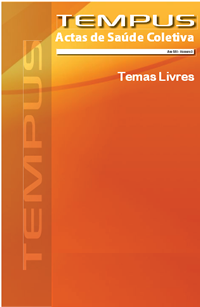Abstract
Objective: learn the myths and fears related to childbirth primigravidae second at the end of pregnancy, and the confirmation or otherwise of these myths and/or fears during the late puerperium. Method: this is a descriptive study with a qualitative approach using the technique of in-depth open interviews and questionnaires at two different times: initially provided to pregnant and postpartum women later. The data were gathered in a public hospital in Goiânia city after approval of the research ethics committee (0004.0.168.000-08); content analysis was established to identify the themes. Results: three categories emerged: the arrival of a baby, the real meaning of natural birth and myths and fears that permeate the birth. Conclusion: pain was identified as the main cultural factor that interferes in choosing the type of delivery in the first pregnancy. And the normal delivery was associated with the demystification about the birth by pregnant women.References
Miranda DB, Bortolon FCS, Matão MEL, Campos PHF. Parto normal e cesária: representações de mulheres que vivenciaram as duas experiências. Rev eletrônica enferm [Internet]. 2008 [cited 2013 Jan 13;10(2):337-46. Available from: http://www.revistas.ufg.br/index.php/fen/article/view/8032/5811.
Tedesco RP, Maia Filho NL, Mathias L, Benez AL, Castro VCL, Bourroul GM et al. Fatores determinantes para as expectativas de primigestas acerca da via de parto. Rev bras ginecol obstet [Internet]. 2004 [cited 2013 Jan 23];26(10):791-8. Available from: http://www.scielo.br/pdf/rbgo/v26n10/22906.pdf.
Almeida NAM, Martins CA, Vasconcelos KL, Rios CHA, Lucas EA, Machado EA et al. A humanização do cuidado à parturição. Rev eletrônica enferm [Internet]. 2005 [cited 2012 Dec 20];7(3):355-9. Available from: https://www.revistas.ufg.br/index.php/fen/article/view/892/1077.
Monteiro MAA, Tavares TJL. A prática do grupo de gestantes na efetivação da humanização do parto. Rev RENE [Internet]. 2004 [cited 2012 Oct 22];5(2):73-8. Available from: http://www.revistarene.ufc.br/revista/index.php/revista/article/view/926/pdf.
Martins CA, Almeida NAM, Souza MA, Cande TA, Siqueira KM, Barbosa MA. Casas de parto: sua importância na humanização da assistência ao parto e nascimento. Rev eletrônica de enferm [Internet]. 2005 [cited 2013 feb 03];7(3):360-5. Available from: http://www.revistas.ufg.br/index.php/fen/article/view/891/1075.
Vaucher ALI, Durman S. Amamentação: crenças e mitos. Rev eletrônica enferm [Internet]. 2005 [cited 2013 Jan 03];7(2):207-14. Available from: http://www.revistas.ufg.br/index.php/fen/article/view/881/1055.
Brasil. Resolução no 466, de 12 de dezembro e 2012 [Internet]. Brasil; 2012 [cited 2013 jul 10]. Available from: http://conselho.saude.gov.br/resolucoes/2012/Reso466.pdf
Beck CLC. Gonzales RMB. Leopardi MT. Detalhamento da fenomenologia. In: Leopardi MT. Metodologia da pesquisa na saúde. Santa Maria: Pallotti; 2001:187-209.
Bardin l. Análise de conteúdo. Lisboa, Portugal: Casagraf, 2007.
Hotimsky SN, Rattner D, Venancio SI, Bógus CM, Miranda MM. O parto como eu vejo...ou como eu o desejo? Expectativas de gestantes, usuárias do SUS, acerca do parto e da assistência obstétrica. Cad saúde pública [Internet]. 2002 [cited 2014 jan 05];18(5):1303-11. Available from:http://www.scielo.br/pdf/csp/v18n5/11003.pdf.
Mota EM, Oliveira MF, Victor JF, Pinheiro AKB. Sentimentos e expectativas vivenciados pelas primigestas adolescentes com relação ao parto. Rev rene [Internet]. 2011 [cited 2013 ago 15];12(4)692-8. Available from: http://www.revistarene.ufc.br/revista/index.php/revista/article/view/284/pdf.
Gurgel AH, Cruz NL. Fenômeno da dor no trabalho de parto: depoimentos de parturientes.Rev baiana enferm. 1997;10(1/2):71-94.
Osava RH, Mamede MV. A assistência ao parto ontem e hoje: a representação social do parto. J bras ginecol. 1995;105(1/2):3-9.
Mandarino NR, Chein MBC, Monteiro Júnior FC, Brito LMO, Lamy ZC, Nina VJS et al. Aspectos relacionados à escolha do tipo de parto: um estudo comparativo entre uma maternidade pública e oputra privada, em São Luís, Maranhão, Brasil. Cad saúde pública [Internet]. 2009 [cited 2013 feb 20];25(7):1587-96. Available from: http://www.scielo.br/pdf/csp/v25n7/17.pdf.
Capra F. O ponto de mutação. São Paulo: Cultrix, 1982. 135p.
Rattner D. Sobre a hipótese de estabilização das taxas de cesárea do Estado de São Paulo, Brasil. Rev saúde pública [Internet]. 1996 [cited 2013 jan 27];30(1):19-33. Available from: http://www.scielo.br/pdf/rsp/v30n1/5039.pdf.
Heymans H, Winter ST. Fears during pregnancy and interview study of 200 postpsrtum
women. Israel j medical sciences.1975;11(11):1102-5.
Azevedo KR, Arrais AR. O mito da mãe exclusiva e seu impacto na depressão pós-parto. Psicologia: reflexão e crítica. 2006;19(2):269-76.
Camara MFB, Medeiros M, Barbosa MA. Fatores sócio-culturais que influenciam a alta incidência de cesáreas e os vazios da assistência de enfermagem. Rev. Eletr. Enf. [Internet] 2000;2(1). [cited 2013 july 22]. Available from:http://www.fen.ufg.br/revista/revista2_1/Cesarea.html.
Ferreira AGN, Ribeiro MM, Dias LKS, Ferreira JGN, Ribeiro MA, Ximenes Neto FRG. Humanização do parto e nascimento: acolher a parturiente na perspectiva dialógica de Paulo Freire.Rev enferm UFPE on line [Internet]. 2013 [cited 2013 Jun 02];7(5):1398-405. Available from:http://www.revista.ufpe.br/revistaenfermagem/index.php/revista/article/view/3721/pdf_2531.
A Tempus garante critérios rigorosos, por meio de avaliação sistemática. Os autores se responsabilizam pela veracidade e ineditismo do trabalho cabendo a eles a cessão de direitos de publicação à revista. A confiabilidade dos conteúdos e a marca própria de apresentação tem como objetivo uma comunicação personalizada, adaptada aos padrões da revista, na medida em que adota critérios de excelência exigidos por seus usuários e especialistas, considerando os rigores da comunicação científica. Os autores devem especificar sua contribuição individual na concepção, delineamento, execução do trabalho, análise ou interpretação dos dados, redação e aprovação final do manuscrito. Incluir Fontes de financiamento e de apoio logístico das pesquisas. Ao final da submissão do artigo, os autores devem enviar uma declaração de cessão de direitos de publicação à Revista TEMPUS , assinada e no formato PDF (Portable Document Format ): Modelo da declaração de cessão de direitos.
